Home | Front Page | Blog | Index | New | Contact | Site Map
Vientiane
Vang Vieng
Luang Prabang
To Phonsavane & back
Plain of Jars
Pathet Lao War
Luang Nam Tha
Guest Houses
Foto Show

China 2001
Vietnam 2001
Laos 2001
Thailand 2001
Cambodia 2001
Britain 2001
USA 2001
Click on photos to open them full size.
Visiting Laos Hill Villages |
It was extremely hot that day in Luang Prabang, former royal capital of Laos, and we had just been to our favorite fruit shake stall for an iced mixed fruit shake. At 2000 Kip, or 25c for a pint glass of a creamy mixture of banana, pineapple, lemon and ice, they were absolutely the best deal in town. On the main street, a tuk-tuk driver spotted us and stopped us to ask if we would like to be taken to the waterfall or the cave that were both out of town. We weren't interested but Gerry asked him, on the off chance, if he knew somebody with a car for rent. As luck would have it, he did, and the person he knew just happened to drive by at that very moment. The tuk-tuk driver hailed him and that is how we met Chanthi, our driver for a 6-day odyssey to the Plain of Jars and back.

Jan & Gerry with Chanti's van |
The old saw says that getting there is half the fun. In the case of Laos's Plain of Jars, getting there and back was 90% of the fun. Yes, the stone jars that give the plain its name are interesting, intriguing even, and worthy of more than a few entries in our photo album. But they are the stuff of a few hours. The journey to the Plain of Jars and back lasted five days and was fascinating for hours on end and breathtakingly beautiful besides.
Our transportation was a 12-passenger van that gave us lots of room to breathe even with all of our luggage. And we always have lots of luggage — right now it’s two daypacks, two backpacks, a large sports bag, and a hard-shell suitcase. But although we were alone when we set out from Luang Prabang, we had not planned it that way. In fact, we had several candidate passengers for the outward journey but for one reason or another none of them panned out.
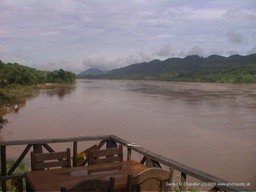
View of the Mekong |
Day 1 — Luang Prabang to Nong Khiaew
The day started slow with a lazy breakfast of yoghurt and fruit at our favorite cafe on the main street of Luang Prabang. By the time we drove out of town along the Mekong headed for the village of Nong Khiaew, some 200km away, the sun was well up and the day already warm. Our first stop, however, was only a couple of kilometers down the road where we stopped at a riverside restaurant built out into the water so that we could admire the river. Since our first encounter with the Mekong in the delta area of South Vietnam , Jan has always been filled with a sense of mystery and excitement that the river generates. She has to pinch herself. “Is it really me? Am I really here looking at the mighty Mekong? “ whenever she sees it. Soon afterwards the road climbed up out of the Mekong valley and into the valley of the Nam Ou (River Ou) which we would follow with a couple of diversions all the way to Nong Khiaew. The further we went, the narrower the valleys, the steeper the mountains, and the more excited our oohs and aahs at the views.
Before leaving Gerry had carefully prepared Chanthi for our habit of making multiple stops along the route. Sometimes they would be short, just time enough to take a photo or shoot a couple of minutes of video. But sometimes they would be longer, time to explore a side road, a village, or just to walk instead of riding and loosen up stiff muscles. Apart from our stop near the Mekong, for example, we also stopped to walk through two different roadside villages. This was to be the pattern for the rest of the trip.
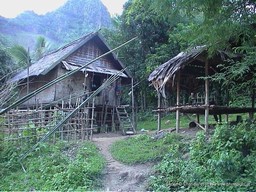
Tribal House |
We were already delighted with our investment in the car. It allowed us to travel without needing to worry about schedules or timetables and without having to haul our bags into and out of buses and taxis. We both had plenty of room to spread out and with windows all around both had a great view of the countryside we were passing through. What more could one ask.
We covered the first 130 km to the junction with Route 1 and the crossroads town of Pak Mong in a couple of hours, and stopped just long enough to buy a large ripe papaya and a bunch of bananas. An hour later, as the day’s heat was reaching its peak we arrived in Nong Khiaew, a small village on the banks of the Nam Ou set amid rugged limestone peaks riddled with caves.
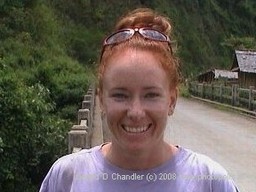
Jennifer Ovens |
We checked into one of the handful of guesthouses, ate a lazy lunch to escape from the heat and then spent the rest of the day taking a 4 km walk up a side valley through villages of stilt houses and past dry rice fields to one of those limestone caves. We were joined on our outing to the cave by some backpackers that we had met over lunch. One of them, Jennifer Ovens a Canadian tour guide and amateur photographer, would be our companion not only for the afternoon but for the rest of our excursion to the Plain of Jars.
As we retraced our steps toward Nong Khiaew, we greeted and were greeted by lots of the local villagers either walking to or from the village water source for their evening bath. The water source can vary from a faucet to a well, from a mountainside spring to a stream or pond. Bathing is therefore a public activity in which female modesty is protected by means of a piece of thin cotton cloth something like a sarong. In these villages, the water source seemed to be spring water that was piped down the hillside to the roadside drainage channel. In the gathering darkness we too were looking forward to the novelty of a cold water bucket bath. There is nothing like sluicing buckets of cold water over the head to refresh and reinvigorate after a hot day’s travelling. Ah the joys of mountain living!
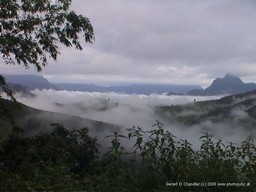
Cloud-filled Vista |
Day 2 — Luang Prabang to Nong Khiaew
Our second day was just about the longest travel day of our entire trip. We were up at first light and on the road by 6:30 but this time with an extra passenger. In Nong Khiaew we had met Jennifer, a Canadian tour guide and amateur photographer, who travelled with us for the rest of our trip.
As we climbed out of the Nam Ou valley past the cave we had visited the day before, the quality of the road started to degrade. But as fast as the road conditions worsened, the views improved. Not long after leaving Nong Khiaew we were driving along a ridge road and had views for miles of cloud-filled valleys and distant mountain chains. We stopped to drink it all in. It was for views such as these and the opportunity to admire them at our leisure that we had gone to the expense of hiring the van. What a good decision it had been!
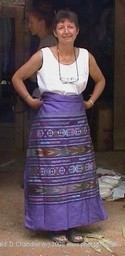
Jan's Handloomed Silk |
Laos’s route 1 was much like the road from Lai Chau to Dien Bien Phu in Vietnam. We were back in the world of ethnic hilltribes and their high mountain villages, vertical farm fields, and slash and burn agriculture. The morning passed quickly as we bumped along the narrow mountain road, stopping periodically in the villages, large and small, that dotted the highway. Oftentimes, the village was only one house deep and beyond was a steep drop off into the valley below. Sometimes, the village was a cluster of houses perched on a knoll to one side of the road. In one, we were attracted by an old man sitting on his front porch weaving baskets. In another it was a hand loom that caught our eye and led to the purchase of a wonderful length of hand-woven silk that Jan later had made into a stunning outfit. The people were always friendly although sometimes a little overwhelmed by the gadgetry we were carrying but ultimately they were as interested in us as we were in them. Each village was different, but each of interest.

Water Wheels |
Just before we got to our lunch stop, the village of Vieng Thong, the road crossed a high bridge over a river in which we caught sight of a strange sight. The local people were using water power to crush and husk their rice. Just by the river bank, a deep channel had been dug out and into it were set a half dozen or more water wheels. Each wheel was used to drive a spindle through which a plank had been inserted. The plank pushed down on one end of a lever the other end of which was weighted. As the spindle turned, the lever was pushed further and further down until eventually the plank released the lever and the weighted end dropped into a stone container that held the rice. In essence it was a water-driven mortar and pestle. We had seen foot-operated versions of the same thing several times, but this was the first time we had seen water wheels used to power them.
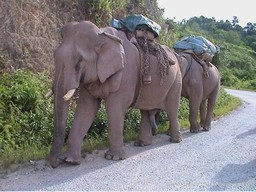
Elephant Train |
Vieng Thong did not offer much in the way of food, but we scraped together enough to satisfy our hunger pangs and went on our way. The afternoon was equally varied and just as avidly recorded and photographed. In particular, we came across a group of elephants being walked along the road by their drivers. It was not quite the encounter with wild elephants that we would have wished, but it still afforded us lots of excitement.
In spite of the excitement, by five o’clock we all started wondering when we would see Nam Neun, where we planned to stop for the night.
Our driver, Chanthi had given us estimates of driving times before we left Luang Prabang, but the further we got from his home base, the less reliable his estimates became, convincing us that this was the first time he had ventured so far afield. We were guinea pigs! We were confirmed in that opinion when we pulled up in the center of a rough-looking mountain village and he announced that we were in Nam Neun. We crawled out of the van to explore and quickly determined that we were in fact at the junction of Route 1 with Route 6, the road to Sam Neua. Nam Neun should be further ahead on Route 1. We had been assured by Chanthi that we could get accommodation at Nam Neun but just in case, we took a look at the only guesthouse in this village. We had found the Nong Khiaew guesthouse pretty basic, but this was even more primitive than our farmhouse stay in Coc Ly, Vietnam , i.e. a space to sleep and little else besides. We were all relieved when Chanthi reported that we still had 7 km to go to Nam Neun.
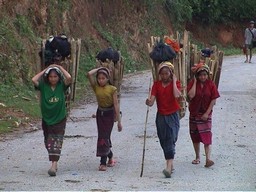
Carrying Firewood for Cooking |
Seven kilometers further downhill, we found Nam Neun a vastly more modern place than the village. Here there were three guesthouses and some places even had electricity, although as we later found out a lightbulb and a switch don’t automatically mean that electric power flows. We first stopped at a motel like bulding across the highway from the main village. Although the rooms were simple, they did have real beds and there was also a separate bathroom with a stoop toilet and a cold bucket bath. After investigating the other things on offer, we haggled with the owner until we found a price that satisfied us all. Gerry and I paid 10,000 Kip ($1.25) for our room and Jennifer 8,000 ($1) for hers given that she had no roommate. We have no idea what, if anything, Chanthi paid for his room. We thought it possible he would get it for free for bringing us.

Traditional Stilt House |
After transferring bags from the van to our rooms, we walked over to the village proper in search of dinner. Chanthi chose the restaurant for us and after some discussion ordered fish soup and sticky rice for everyone. By now it was completely dark but by some miracle, the restaurant had electric power, evidenced by the very weak electric bulb that was burning and the fan that was blowing. Gerry was delighted. He would be able to charge the battery of his video camera. He always carried a spare, but hated it when he couldn’t charge either one. When the food came, it was a wonderful surprise. The soup broth was very tasty and spicy and was filled with huge chunks of meaty fish. Chanthi told us it was fish caught in the local river that day. We were all hungry and wolfed it down and then walked back to the hotel.

Making Baskets |
Once there we were disappointed to see that although the building had an electric power supply, as evidenced by the bulb burning on the porch in front of our rooms, neither the bedrooms nor the bathroom had power. That meant an evening bucket bath by flashlight and going to bed by candlelight. It didn’t much matter. By ten p.m. we were all dead to the world.
Day 3 — Nam Neun to Phonsavane
Today we had only a half day of travel, this time on gradually improving roads the closer we got to Phonsavane. We left Nam Neun just after daybreak, having gone to bed by 9 the previous night and arrived in Phonsavane just before noon. We were curious about the Plain of Jars. How big was it, how many jars would there be and how evident woud they be? We were surprised therefore to find that the name is a misnomer. It is not a plain at all, but a countryside of low rolling hills. Perhaps in contrast to the steep rugged limestone mountains that we had just come through, the low hills seemed rather flat, but a plain it was not. After lunch we set out to visit one of the sites but after a while it seemed likely to Gerry and then it became obvious to Chanthi that out of unfamiliarity he had missed the turn off. After a rapid consultation we decided to continue on to Xieng Khoung where we explored the town, now partly rebuilt after near total destruction during its occupation by Vietnamese troops.
Day 4 — Phonsavane
In the morning we tried again for the stone jars and this time found — because of greater care — all the turn offs and visited the three largest and most famoust sites containing remains of the stone jars that give the infamous Plain of Jars its name. After a late lunch we took the road west that leads to Luang Prabang to see with our own eyes that it was impassable; that we could not take what the map showed as a short, 120 km route to L. P.. For the first 52 kilometers we found one of the most modern highways in Laos. Then suddenly, with hardly a transition, it turned to dirt. Immediately we came to a place where one of the ruts was shoulder deep (we climbed into it). We left our car behind and walked west along the road through rice country and simple villages as far as we could before daylight started to fade. Then we walked and rode back to Phonsavane truly convinced that we'd have to return the long 250 km way to Luang Prabang.
Day 5 — Phonsavane to Vieng Thong
Day 5 was expected to be a very long day of travel given that we were planning to compress the three days of travel of the outbound journey into only two days for the return. Nonetheless, we maintained our habit of stopping at every vista and especially whenever we passed through an interesting looking village. One stop was memorable but not exactly enjoyable. While we had been in Phonsavane, a truck had gone off the road killing the driver and we got to that spot a team of people were trying to winch the truck back up onto the road. It was a sobering reminder that bad roads are dangerous.

Cooling the Blood |
During both the outbound and return parts of the journey, we would sometimes find the road blocked by animals of various kinds. The villagers let all of their animals run free so that they could forage for their own food, thus removing that burden from their owners. For Chanthi, that meant playing dodgems with hens and turkeys, and even more often with hen and turkey chicks. Other moving obstacles were pigs and especially piglets. Once we even encountered a pig suckling her young by the side of the road. More often immobile were dogs and cattle which seemed to love to sleep in the middle of the road, attracted by the warmth of any spot open to the sun’s warmth. They were often hard to get moving; rarely budging until the car was on top of them. Buffalo, on the other hand, preferred a pond or a mudhole to the road.
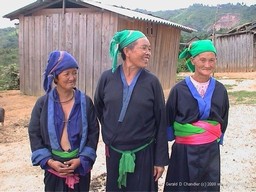
Colorful Cummerbunds |
It was on the return journey that Gerry got to try his hand, or rather his foot, at operating the rice crusher. Here too, we found some villagers who were delighted to show off their colorful scarves and cummerbunds. Further on, we found a roadside market and had fun trying to identify strange fruits and vegetables. We saw tomato-sized green eggplants and conical bamboo shoots among other things. We stopped at Nam Neun for lunch hoping to get another excellent fish soup. Alas, it was not to be. We did have fish soup, but somehow not as delicious as the dish we remembered from our previous visit.

Where God made the scenery |
We were a little surprised to find ourselves in Vieng Thong shortly after 4 p.m. We had not expected to be there before dark. Overnight accommodation was hardly more plentiful than good lunch food had been on the outward journey.
Chanthi scouted out rooms for us. After finding one guesthouse full and another too dirty, we ended up in the third, a small wooden stilt house in which the floors didn’t seem to have been swept for weeks. Goodness knows whether the bed linen was clean, but taking no chances Jan decided to sleep fully clothed. Heaven knows what the ‘dirty’ guesthouse was like.
The one saving grace of the Santisouk Guesthouse was the balcony that ran along the front of the building and where we sat later in the gathering darkness munching on whatever fruit and snacks we were carrying rather than brave the restaurants of Vieng Thong again. Like Nam Neun, except for an odd generator, the village was not yet hooked up to the power grid and so, faute de mieux, soon after dark we went to bed by candlelight.
Day 6 — Vieng Thong to Luang Prabang
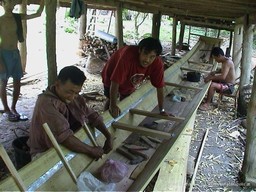
Building a boat |
It should by rights have been a boring day. We had done it all before, had already spent three days travelling these mountain roads, and surely by now must be sated. But it was not to be. We started the day very early again, given our early night, and started out with a five km walk along the road out of Vieng Thong. Chanthi was happy to get an extra half hour for his breakfast and we were happy to stretch our legs and our heart muscles for a slightly uphill walk. We were disappointed by the morning mist and the lie of the road which meant that we did not get the wonderful views we would have preferred, but the ultra fresh air and the cool early morning temperatures helped compensate.
As the day wore on, we found ourselves surprised by how little we remembered of what we had thought to be such a memorable journey just three days before. Thank goodness we had photos and videos to remind us of at least parts of it. And thank goodness also for this second chance to see and admire and record.After we stopped in Nong Khiaew for a late lunch, for example, we walked out of the village and came across a group of men building a flat-bottomed boat for use on the river. Coming the other way, we had not noticed them at all.
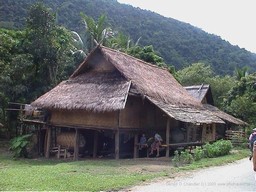
Boatbuilder's House |
The last few hours went by in a flash as we got back onto the high quality surface of Route 4. We pulled into Luang Prabang just before six in the evening, tired, dirty, but very very happy with our PDJ Odyssey. Gerry and I checked into the Phousi Hotel and delighted in the luxury of a real hot shower, air-conditioning, reliable electric power supply, and clean white bed linen. Ahhh!
P.S. Much later, while we were in Thailand, we discovered a wonderful memoir about some of the parts of Laos that we had traversed on this trip. Written by an American medical doctor who worked for USAID during the 1960’s, it gives a most interesting picture of the remote northern parts of Laos before and during the communist insurgency. See “Tragedy in Paradise” by Charles Weldon.